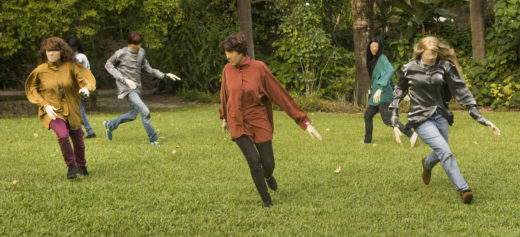- Under the water was sand, then rocks, miles of rocks, then fire

- A JAMBOREE OF HOODLUMS: Wallace Stevens on Miami
Transplants
Catherine Annie Hollingsworth
 Ana Mendez, Transplants, The Kampong. Rachel Carroll, Rick Diaz, Marcela Loayza, Jenna Balfe, and Monica Uszerowicz. Photo: Mitchell Zachs
Ana Mendez, Transplants, The Kampong. Rachel Carroll, Rick Diaz, Marcela Loayza, Jenna Balfe, and Monica Uszerowicz. Photo: Mitchell Zachs
DECEMBER 17, 2016
Moving through grass, trees, and tropical flora, choreographer Ana Mendez’s Transplants is a creepy-cool meditation on the nature of belonging. Her performers are human, yet the characters they portray operate on an alternate frequency. Transplants was conceived as a story about the lives of plants.
The project was created for the Pioneer Winter Collective’s 2016 Grass Stains program, in which four choreographers were commissioned to compose site-specific performance pieces. Mendez chose the Kampong, one of Miami’s lesser-known curiosities. The Coconut Grove property was purchased in 1916 by horticulturist and explorer David Fairchild. He made it a home for his family and his growing collection of rare tropical flora brought back from his expeditions, searching throughout the world for plants that could be successfully introduced to South Florida.
Fairchild would make for a compelling main character in a site-specific work, but Mendez’s Transplants focuses more on the experience of the plants themselves, which are represented as conscious beings with feelings. Her performers are the alien exotics that had been brought by ship—she imagines—to a place where they did not at first belong. And as plants do, the characters sense the environment around them, and adjust in order to survive. In concept, this has much to do with the experience of immigrants who are compelled first to survive their journey and then to adapt to the cultures and circumstances of their new home.
The dancers’ bodies are made strange by distortions. Their faces are featureless, covered in various shades of sheer hosiery that obscure the details of eyes, noses, mouths, and ears, leaving only silhouettes of faces framed by wigs. The dancers wear oversized shirts and their arms are elongated with mannequin hands, making for unsettling proportions and a sense that they could not fully touch one another or the objects in the spaces around them. A guardian, the only human character, lingers in the background with a walking stick and a lawn chair. He seems to be orchestrating the scenario. Fairchild, maybe.
Through awkward movements and the droning noise that follows them through the gardens, the plant-beings appear to be both disembodied from themselves and disconnected from their surroundings. They walk, sit, reach, stumble, and fall. They feel for things around them, and gaze toward one another. Mendez’s choreographic style here is less dance, more pedestrian physicality. Her performers exhibit a range of formal training—the dancers in the bunch move with more controlled movements, while the others move in less familiar ways, producing genuinely strange gestures and gaits. Over the course of the performance, they begin to shed their clothes and artificial parts, becoming more human in appearance, regaining restrained access to their abilities to touch, see and feel. Even in this transformation, isolation resonates in Transplants. But it isn’t an intellectual experience—it is instead an engagement with a surreal feeling of disembodiment and a fantasy of a deeper understanding of life forms whose struggle may be just as complicated as our own.









